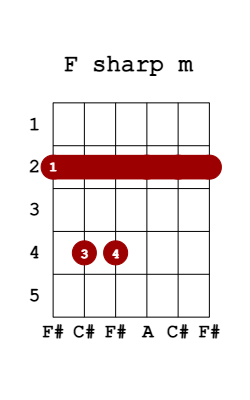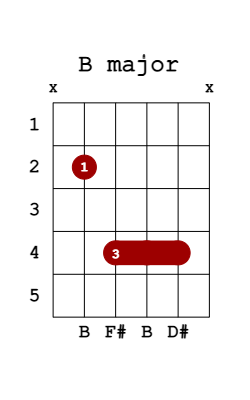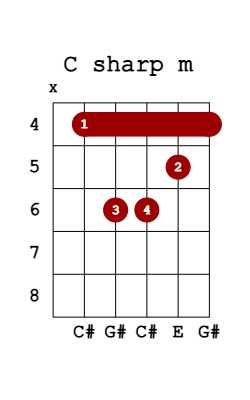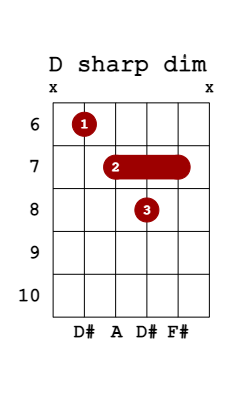The E major scale has 7 notes, which means that there will be 7 chords in the key of E. Each chord will root on a note of the scale.TIP: The chords of any major key will always have the following major-minor pattern:
Popular chord progressions in the key of E
| Progression | Chords |
|---|---|
| I-IV-V | E-A-B |
| I-IV-I-V | E-A-E-B |
| I-V-vi-IV | E-B-C#m-A |
| I-ii-IV-V | E-F#m-A-B |
| I-vi-ii-V | E-C#m-F#m-B |
| I-vi-IV-V | E-C#m-A-B |
What if E is not the 1st chord?
Even when songs begin elsewhere, certain progressions inevitably lead back to E major, revealing the true key center:
| Progression | Chords | Notes |
|---|---|---|
| IV-V-I | A-B-E | This essential cadence progresses from A to B before resolving to E. The B major chord functions as a dominant, creating irresistible forward motion that confirms E as the key's foundation. |
| ii-V-I | F#m-B-E | Flowing from F#m through B to E, this progression is a cornerstone of jazz harmony but appears across all styles. The stepwise bass movement (F#-B-E) provides clear harmonic direction toward the tonic. |
Why are these the chords in the key of E major? (the theory)
Before moving on, you'll want to familiarize yourself with the theory of the major scale theory on guitar before continuing this lesson. So the chords in E will root on the notes along the E major scale, since all chords in a major key are formed by notes from their respective diatonic scale.
The E major scale has 7 notes, each with a corresponding scale degree:
Degree: 1 2 3 4 5 6 7 1(octave)
Note: E F# G# A B C# D# E
But how do we know which chord will be major or minor?
Starting from a given root note, we need to form its triad in a way which leaves the chord constructed only from notes that can be found on the E major scale.
This means that starting from each root note, we’ll count out the 1st 3rd and 5th degrees along the major scale of that given root note. We than compare these notes with the notes of the E major, and if any single note is not in our key, we’ll have to flatten it to make it a note that can be found on the E major scale. Confusing? Have no fear, we'll get to some examples shortly.
We’ll be differentiating 3 triads:
- Major triad (major chords) with scale degrees 1 3 5
- Minor triad (minor chords) with scale degrees 1 b3 5
- Diminished triads (diminished chords) with scale degrees 1 b3 b5
Now let’s calculate the quality of each chord in the key of E.
The key of E is a bit harder (than the key of G for example), since we have a lot of sharps, but it's good practice!
E major
Note: E F# G# A B C# D# E
Triad: 1 3 5
This gives us the notes E, G# and B, which is the E major triad, therefore the first chord in the key of E is E major.F# minor
Note: F# G# A# B C# D# E# F#
Triad: 1 3 5
So our 3rd note for would be an A#, but we can’t have that, since that note is not in the key of E major (not on the E major scale). This means we have to flatten the 3rd.
Note: F# G# A B C# D# E# F#
Triad: 1 b3 5
This gives us the notes F#, A and C#, which is the F# minor triad. All of these notes are on the E major scale as well, therefore the second chord in the key of E is F# minor.G# minor
Note: G# A# B# C# D# E# F## G#
Triad: 1 3 5
So our 3rd note would be a B#, but again, we can’t have that, since that note is not in the key of E. We have to lower the 3rd to the flattened 3rd.
Note: G# A# B C# D# E# F## G#
Triad: 1 b3 5
This gives us the notes G#, B and D#, which is the G# minor triad, therefore the third chord in the key of E is G# minor.A major
Note: A B C# D E F# G# A
Triad: 1 3 5
This time we’re in luck, the 1st, 3rd and 5th of the A major scale are in the key of E, so we don’t need to modify any of the notes. We get the notes A, C# and E, which is the A major triad, therefore the fourth chord in the key of E is A major.B major
Note: B C# D# E F# G# A# B
Triad: 1 3 5
Again, the 1st, 3rd and 5th of the B major scale are in the key of E, so we don’t need to modify any of the notes. We get the notes B, D# and F#, which is the B major triad, therefore the fifth chord in the key of E is B major.C# minor
Note: C# D# E# F# G# A# B# C#
Triad: 1 3 5
Again, we need to modify our 3rd note, which would be an E#, since that note is not in the key of E. We have to lower the 3rd to the flattened 3rd.
Note: C# D# E F# G# A# B# C#
Triad: 1 b3 5
This gives us the notes C#, E and G#, which is the C# minor triad, therefore the sixth chord in the key of E is C# minor.D# diminished
Note: D# E# F##G# A# B# C##D#
Triad: 1 3 5
Oh what a mess, it's not enough that D# has two double accidentals, we also need to flatten the 3rd AND the 5th, since neither the F##, nor the A# are on the E major scale.
Note: D# E# F# G# A B# C##D#
Triad: 1 b3 b5
This gives us the notes D#, F# and A, which is the D# diminished triad, therefore the seventh chord in the key of E is D# diminished.
And that's about it, you should now know the intricacies of chords in the key of E. This was a much more difficult key to work with, due to all of those sharps, but it's important to know because the key of E is a popular key as well.
Have a look at guitar chords in other keys as well.











